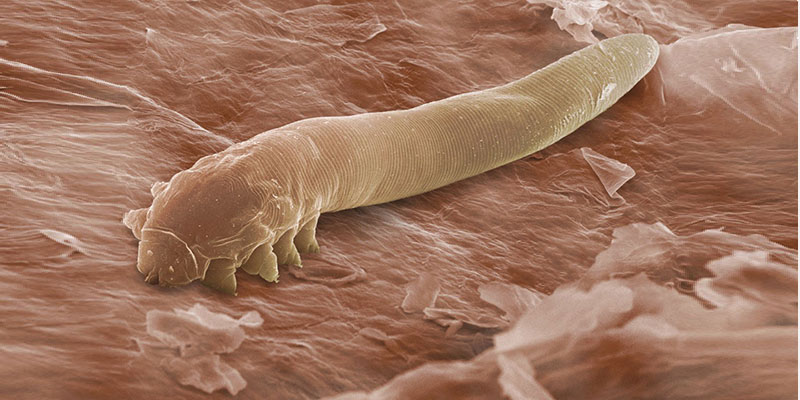“Eyelash mites” is the common name for Demodex mite species that inhabit the hair follicles or oil glands around your eyes. Mites are arachnids, related to spiders, and have eight legs, two long body segments, and an exoskeleton. Eyelash mites are microscopic and cannot be seen by the naked eye. They are very common and most of the time are innocuous, but sometimes they can get out of hand and cause a range of eye-related problems.
There are many species of Demodex mites, but only two affect humans; they are Demodex brevis, which lives within the sebaceous or oil glands in the skin around the eyes, and Demodex folliculorum, which lives within the hair follicles of the eyelashes. Eyelash mites spend most of their lives within these burrows, eating skin cells and oil, only coming onto the surface of the skin at night to search for mates.
Eyelash Mites – What Happens if They Get Out of Hand?
Infestation with eyelash mites is actually extremely commonplace. Recent studies suggest that over half of young adults have eyelash mites. That number increases to over 80% for adults over the age of 60, and nearly 100% for those over the age of 80. Eyelash mites are passed from person to person through contact with facial skin, such as during hugging or kissing. Most of the time, eyelash mites do not cause any symptoms and go unnoticed, which is why the rates of Demodex prevalence in humans are believed to be underestimated. However, in cases where a person’s immune system is weakened or the mites become overpopulated, they can trigger various irritations and disorders of the eyes.1
Skin cell consumption, scratching by mite claws, and reactions to exoskeleton proteins may all cause damage and lead to an inflammatory response by the body’s immune system. This causes the characteristic symptoms of inflammation: swelling, redness, warmth, itching, or soreness, in the eyelid (blepharitis) or the skin around the eyes. Inflammation in turn may cause or exacerbate other eye and skin conditions, such as dry eye disease, madarosis (eyelashes falling out), or rosacea. If left untreated for too long, these conditions could cause permanent eye damage.2
Getting Rid of Eyelash Mites
Eyelash mites are tricky to kill since they spend most of their lives safe within the follicles or glands they eat and sleep in. Eggs are laid within the safety of these burrows as well. The lifespan of eyelash mites, from egg to adult, is about a month.
Cliradex products were developed with 4-terpineol, a strong cleanser derived from Tea Tree Oil that eliminates Demodex mites. However, Cliradex products do not include any extra ingredients that could potentially cause irritation. Therefore, they are gentle enough to use for the length of time required to kill all eyelash mites as they hatch and mature, fully clearing your Demodex infestation. Cliradex Light foaming cleanser is suitable for use as a part of your daily facial hygiene regimen for preventing infestations, while Cliradex Towelettes contain a stronger dose of 4-terpineol and are good for clearing tougher infestations.3 As always, if symptoms of eye discomfort or inflammation do not go away after a few weeks, consult your eye doctor to determine the right treatment for you.
Resources:
- Cheng AM, Sheha H, Tseng SC. Recent advances on ocular Demodex infestation. Current opinion in ophthalmology. 2015;26(4):295-300.
- Luo X, Li J, Chen C, Tseng S, Liang L. Ocular Demodicosis as a Potential Cause of Ocular Surface Inflammation. Cornea. 2017;36 Suppl 1:S9-s14.
- Tighe S, Gao YY, Tseng SC. Terpinen-4-ol is the Most Active Ingredient of Tea Tree Oil to Kill Demodex Mites. Translational vision science & technology. 2013;2(7):2.




